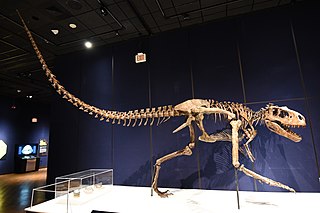
Albertosaurus is a genus of large tyrannosaurid theropod dinosaur that lived in northwestern North America during the early to middle Maastrichtian age of the Late Cretaceous period, about 71 million years ago. The type species, A. sarcophagus, was apparently restricted in range to the modern-day Canadian province of Alberta, after which the genus is named, although an indeterminate species has been discovered in the Corral de Enmedio and Packard Formations of Mexico. Scientists disagree on the content of the genus and some recognize Gorgosaurus libratus as a second species.

Quetzalcoatlus is a genus of azhdarchid pterosaur known from the Late Cretaceous Maastrichtian age of North America. Its name comes from the Aztec feathered serpent god Quetzalcoatl. The type species is Q. northropi, named by Douglas Lawson in 1975. The genus also includes the smaller species Q. lawsoni, which was known for many years as an unnamed species, before being named by Brian Andres and Wann Langston Jr. (posthumously) in 2021. Q. northropi has gained fame as a candidate for the largest flying animal ever discovered.
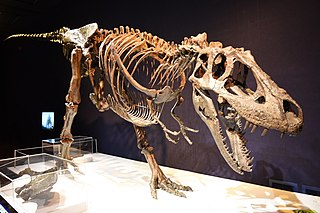
Daspletosaurus is a genus of tyrannosaurid dinosaur that lived in Laramidia between about 78 and 74.4 million years ago, during the Late Cretaceous Period. The genus Daspletosaurus contains three named species. Fossils of the earlier type species, D. torosus, have been found in Alberta, while fossils of a later species, D. horneri, have been found only in Montana. D. wilsoni has been suggested as an intermediate species between D. torosus and D. horneri that evolved through anagenesis, but this theory has been disputed by other researchers.

Stenonychosaurus is a genus of troodontid dinosaur from the Late Cretaceous Dinosaur Park Formation of Alberta, Canada, as well as possibly the Two Medicine Formation. The type and only species, S. inequalis, was named by Charles Mortram Sternberg in 1932, based on a foot, fragments of a hand, and some caudal vertebrae from the Late Cretaceous of Alberta. S. inequalis was reassigned in 1987 by Phil Currie to the genus Troodon, which was reverted by the recognition of Stenonychosaurus as a separate genus from the possibly dubious Troodon in 2017 by Evans et al. and also later in the same year by Van der Reest and Currie.

Gorgosaurus is a genus of tyrannosaurid theropod dinosaur that lived in western North America during the Late Cretaceous Period (Campanian), between about 76.6 and 75.1 million years ago. Fossil remains have been found in the Canadian province of Alberta and the U.S. state of Montana. Paleontologists recognize only the type species, G. libratus, although other species have been erroneously referred to the genus.
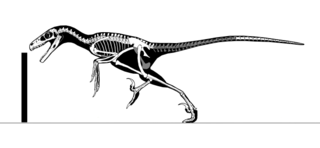
Saurornitholestes is a genus of carnivorous dromaeosaurid theropod dinosaur from the late Cretaceous of Canada (Alberta) and the United States.

Philip John Currie is a Canadian palaeontologist and museum curator who helped found the Royal Tyrrell Museum of Palaeontology in Drumheller, Alberta and is now a professor at the University of Alberta in Edmonton. In the 1980s, he became the director of the Canada-China Dinosaur Project, the first cooperative palaeontological partnering between China and the West since the Central Asiatic Expeditions in the 1920s, and helped describe some of the first feathered dinosaurs. He is one of the primary editors of the influential Encyclopedia of Dinosaurs, and his areas of expertise include theropods, the origin of birds, and dinosaurian migration patterns and herding behavior. He was one of the models for palaeontologist Alan Grant in the film Jurassic Park.

Azhdarchidae is a family of pterosaurs known primarily from the Late Cretaceous Period, though an isolated vertebra apparently from an azhdarchid is known from the Early Cretaceous as well. Azhdarchids are mainly known for including some of the largest flying animals discovered, but smaller cat-size members have also been found. Originally considered a sub-family of Pteranodontidae, Nesov (1984) named the Azhdarchinae to include the pterosaurs Azhdarcho, Quetzalcoatlus, and Titanopteryx. They were among the last known surviving members of the pterosaurs, and were a rather successful group with a worldwide distribution. Previously it was thought that by the end of the Cretaceous, most pterosaur families except for the Azhdarchidae disappeared from the fossil record, but recent studies indicate a wealth of pterosaurian fauna, including pteranodontids, nyctosaurids, tapejarids and several indeterminate forms. In several analyses, some taxa such as Navajodactylus, Bakonydraco and Montanazhdarcho were moved from Azhdarchidae to other clades.

Azhdarcho is a genus of azhdarchid pterosaur from the late Cretaceous Period of the Bissekty Formation of Uzbekistan, as well as the Zhirkindek Formation of Kazakhstan and possibly also the Ialovachsk Formation of Tajikistan. It is known from fragmentary remains including the distinctive, elongated neck vertebrae that characterizes members of the family Azhdarchidae, a family that includes many giant pterosaurs such as Quetzalcoatlus. The name Azhdarcho comes from the Persian word azhdar (اژدر), a dragon-like creature in Persian mythology. The type species is Azhdarcho lancicollis. The specific epithet lancicollis is derived from the Latin words lancea and collum ("neck").
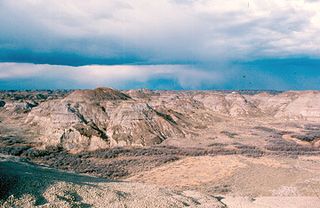
The Dinosaur Park Formation is the uppermost member of the Belly River Group, a major geologic unit in southern Alberta. It was deposited during the Campanian stage of the Late Cretaceous, between about 76.5 and 74.4 million years ago. It was deposited in alluvial and coastal plain environments, and it is bounded by the nonmarine Oldman Formation below it and the marine Bearpaw Formation above it.

Arambourgiania is an extinct genus of azhdarchid pterosaur from the Late Cretaceous period of Jordan, and possibly the United States. Arambourgiania was among the largest members of its family, the Azhdarchidae, and it is also one of the largest flying animals ever known. The incomplete left ulna of the "Sidi Chennane azhdarchid" from Morocco may have also belonged to Arambourgiania.

Hatzegopteryx is a genus of azhdarchid pterosaur found in the late Maastrichtian deposits of the Densuş Ciula Formation, an outcropping in Transylvania, Romania. It is known only from the type species, Hatzegopteryx thambema, named by Buffetaut et al. in 2002 based on parts of the skull and humerus. Additional specimens, including a neck vertebra, were later placed in the genus, representing a range of sizes. The largest of these remains indicate it was among the biggest pterosaurs, with an estimated wingspan of 10 to 12 metres.

Phosphatodraco is a genus of azhdarchid pterosaur that lived during the Late Cretaceous of what is now Morocco. In 2000, a pterosaur specimen consisting of five cervical (neck) vertebrae was discovered in the Ouled Abdoun Phosphatic Basin. The specimen was made the holotype of the new genus and species Phosphatodraco mauritanicus in 2003; the genus name means "dragon from the phosphates", and the specific name refers to the region of Mauretania. Phosphatodraco was the first Late Cretaceous pterosaur known from North Africa, and the second pterosaur genus described from Morocco. It is one of the only known azhdarchids preserving a relatively complete neck, and was one of the last known pterosaurs. Additional cervical vertebrae have since been assigned to the genus, and it has been suggested that fossils of the pterosaur Tethydraco represent wing elements of Phosphatodraco.
Elanodactylus is a genus of ctenochasmatid pterodactyloid pterosaur from the Early Cretaceous period of what is now the Yixian Formation of Liaoning, China.
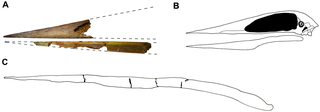
Alanqa is a genus of pterodactyloid pterosaur from the Late Cretaceous period of what is now the Kem Kem Beds of southeastern Morocco. The name Alanqa comes from the Arabic word العنقاءal-‘Anqā’, for a mythical bird of Arabian culture.
Continuoolithus is an oogenus of dinosaur egg found in the late Cretaceous of North America. It is most commonly known from the late Campanian of Alberta and Montana, but specimens have also been found dating to the older Santonian and the younger Maastrichtian. It was laid by an unknown type of theropod. These small eggs are similar to the eggs of oviraptorid dinosaurs, but have a distinctive type of ornamentation.

Navajodactylus is an extinct genus of pterodactyloid pterosaur from Late Cretaceous deposits of the San Juan Basin in New Mexico, United States.
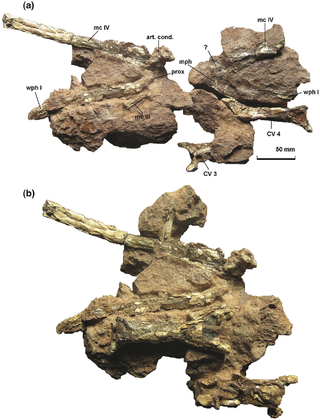
Eurazhdarcho is a genus of azhdarchid pterosaur from the Late Cretaceous period of what is now the Transylvanian Basin of Romania. Its fossil remains dated back 69 million years ago.
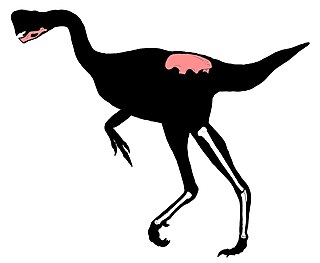
Citipes is an extinct genus of caenagnathid theropod from the Late Cretaceous Dinosaur Park Formation in Alberta, Canada. The genus contains only one species, the type species, C. elegans. The generic name of Citipes is Latin for "fleet-footed", and the specific epithet "elegans" is Latin for "elegant". The type specimen of Citipes has a convoluted taxonomic history, and has been previously assigned to the genera Ornithomimus, Macrophalangia, Elmisaurus, Chirostenotes, and Leptorhynchos before being given its own genus in 2020.

Thanatosdrakon is a genus of quetzalcoatline azhdarchid pterosaur from the Late Cretaceous Plottier Formation of the Neuquén Basin in western Argentina. The genus name is derived from the Greek words thanatos (=death) and drakon (=dragon), while the specific name is a Quechuan word meaning "flying serpent" and refers to the Incan deity Amaru. The type and only species is Thanatosdrakon amaru, known from two specimens consisting of several well-preserved axial and appendicular bones including material previously undescribed in giant azhdarchids. Thanatosdrakon is one of the oldest known members of the Quetzalcoatlinae. T. amaru lived from about 90 to 86 million years ago.





































